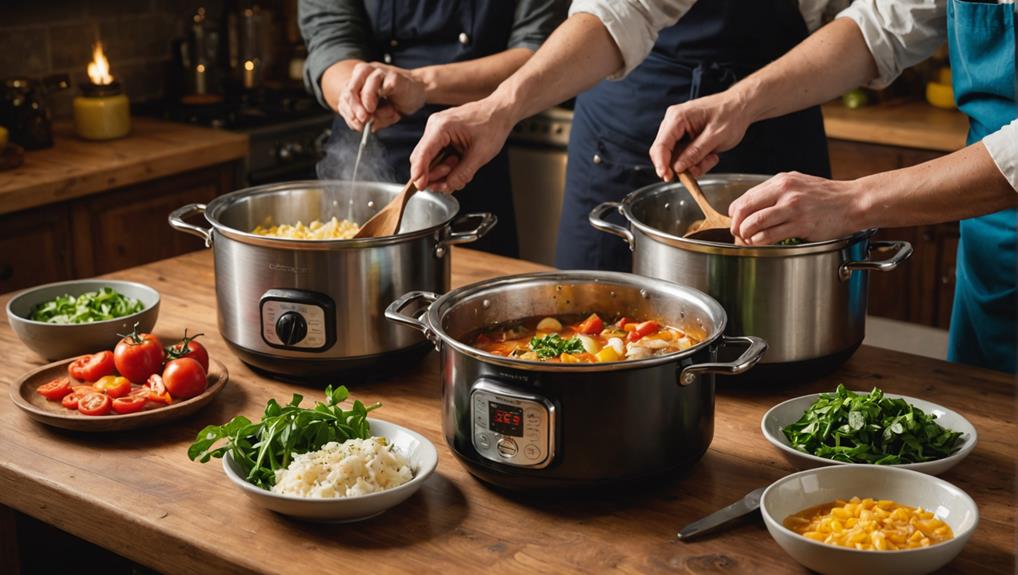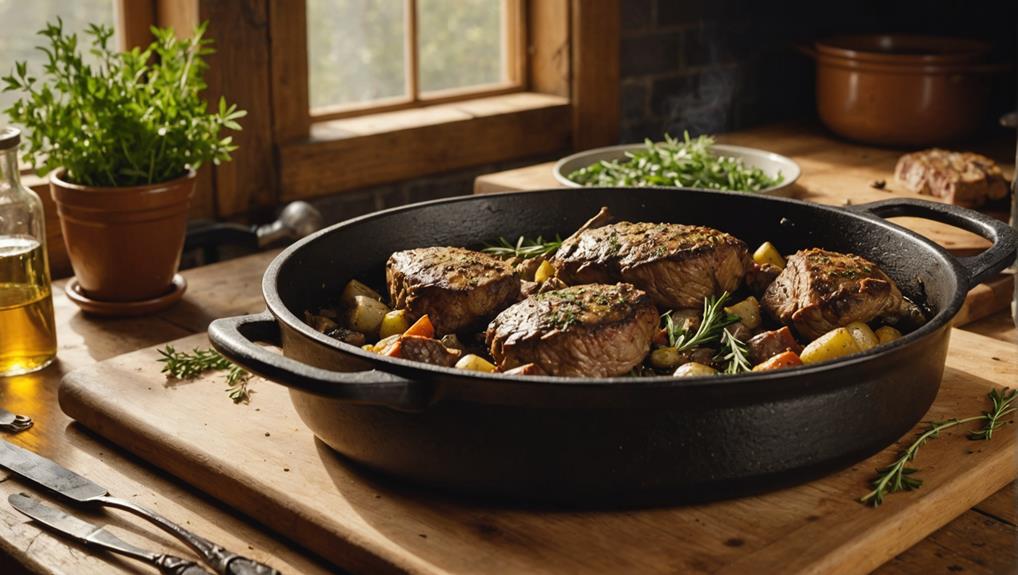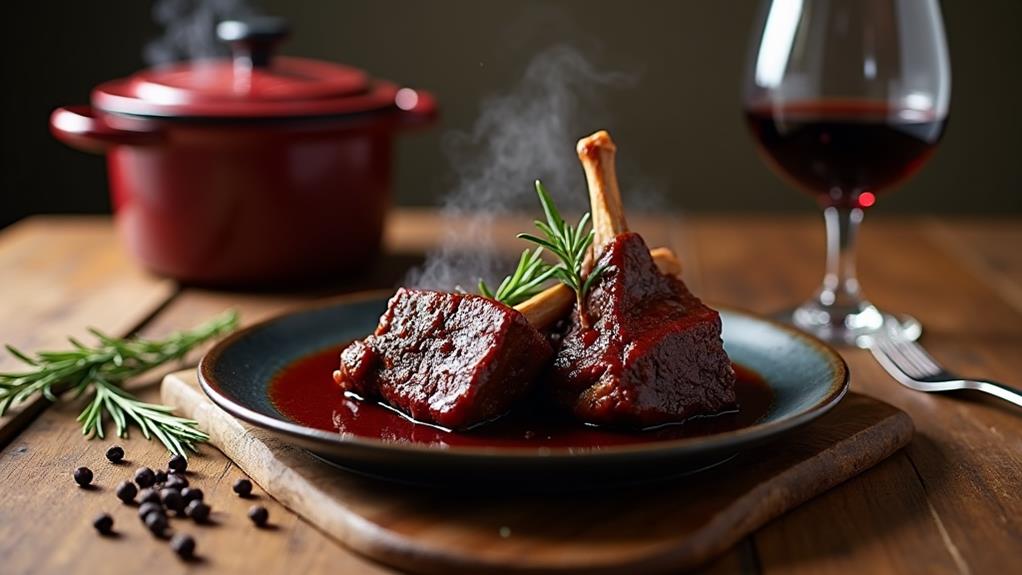When choosing between steaming and pressure cooking, you'll find that both methods offer unique benefits. Steaming excels at preserving nutrients and delicate flavors, making it ideal for vegetables and seafood. It's gentler on food, maintaining texture and color. Pressure cooking, on the other hand, is faster and more energy-efficient, perfect for tougher cuts of meat and hearty dishes. It intensifies flavors but may sacrifice some nutrients. Your choice depends on the ingredients, desired outcome, and time constraints. Both methods promote healthier cooking by eliminating the need for added fats. To make the best decision for your culinary needs, consider the specific advantages of each technique.
Nutritional Battle: Steam Vs Pressure
When it comes to preserving nutrients in your food, steaming often comes out on top. This gentle cooking method maintains more water-soluble vitamins and minerals compared to pressure cooking, which can lead to nutrient loss due to higher temperatures and pressures.
You'll find that steamed foods retain their original flavor and texture better, resulting in vibrant, healthy and delicious meals.
While both methods are healthier than boiling or frying, steaming takes the lead in nutrient retention, especially for delicate foods like vegetables and seafood. It's like giving your ingredients a spa treatment rather than a high-intensity workout.
Pressure cooking, on the other hand, excels at tenderizing tougher foods and reducing cooking times, making it more energy-efficient for large quantities. However, this efficiency may come at the cost of some nutrients.
If you're looking to innovate your cooking routine, consider using a cast iron steamer basket. It'll not only help you preserve nutrients but also add a touch of culinary sophistication to your kitchen.
Flavor Preservation Face-Off
A culinary showdown unfolds in the kitchen as we pit steaming against pressure cooking in the flavor preservation arena. When it comes to maintaining the natural essence of your ingredients, steaming takes the lead. You'll find that this gentle method enhances flavors without overwhelming them, allowing you to savor the true taste of your food.
Additionally, just as the careful preparation of ingredients in recipes like Cranberry Walnut Bread emphasizes the importance of flavor balance, steaming creates a nurturing environment for the natural taste of fresh ingredients.
Steaming excels in herb infusion, creating an ideal environment for delicate aromatics to permeate your dishes. By contrast, pressure cooking's high temperatures can sometimes mute subtle flavors. To maximize flavor intensity, try seasoning techniques tailored for steaming: place herbs directly on your ingredients or infuse the steam itself with aromatic elements.
While pressure cooking offers speed, it may compromise the vibrancy of your vegetables. Steaming, however, preserves both color and texture, ensuring your meals are as visually appealing as they're flavorful.
You'll also appreciate that steaming requires no added fats, letting you enjoy pure, unadulterated tastes. Innovate in your kitchen by experimenting with steam-infused seasonings and layered flavor profiles. This method opens up a world of culinary possibilities, allowing you to create dishes that are both nutritious and bursting with natural flavors.
Energy Efficiency Showdown
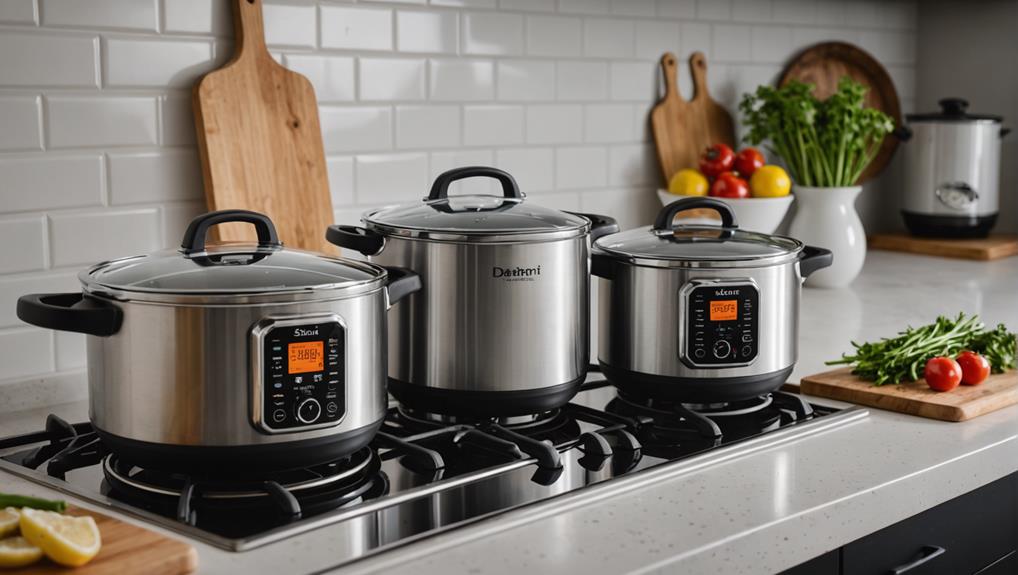
When comparing steaming and pressure cooking for energy efficiency, you'll want to consider cooking time, heat distribution, and fuel consumption rates.
You'll find that steaming often requires less energy due to shorter cooking times and lower heat requirements, while pressure cooking can be more energy-intensive initially but may save energy in the long run for certain dishes.
To make an informed decision, you should weigh the energy costs against the cooking needs of specific recipes and your personal preferences for taste and texture.
Cooking Time Comparison
Let's dive into the energy efficiency showdown between steaming and pressure cooking.
When comparing cooking times, pressure cooking takes the lead, completing meals up to 70% faster than traditional methods. This significant reduction in cooking time translates to lower energy consumption, often using just one-third of the energy required for boiling or frying.
Steaming typically requires 10 to 20 minutes, depending on the food type, while pressure cooking can slash that time to 5 to 15 minutes. This efficiency is particularly evident when preparing:
- Tough cuts of meat
- Grains and legumes
- Root vegetables
- Hearty soups and stews
The pressure cooker's sealed environment not only speeds up cooking times but also affects texture differences and ingredient interactions.
You'll find that pressure-cooked meals often result in more tender meats and perfectly cooked grains. Additionally, the high-pressure environment intensifies flavors, allowing for deeper ingredient interactions in a shorter time frame.
While steaming maintains a consistent energy supply throughout cooking, pressure cooking's brief, intense process ultimately consumes less energy overall.
This makes pressure cooking an innovative choice for time-sensitive recipes and energy-conscious cooks seeking efficiency without compromising on taste or texture.
Heat Distribution Analysis
The heat distribution battle between steaming and pressure cooking reveals stark contrasts in energy efficiency. When you're looking to innovate in the kitchen, understanding these differences is crucial.
Pressure cooking's sealed environment creates a uniform heat distribution, thanks to its advanced temperature regulation techniques. This ensures your food cooks evenly and efficiently, consuming about 7 times less energy per meal than conventional methods.
Steaming, while gentler, offers its own advantages in moisture retention methods. It operates at lower temperatures for shorter periods, typically 10-20 minutes, making it a low-energy option for many foods. However, you might experience variable heat based on food positioning.
The cooking environment effects play a significant role in each method's efficiency. Pressure cooking's high-pressure steam increases boiling point temperatures, leading to faster cooking times and impressive energy savings of about 50% compared to traditional boiling or steaming.
On the other hand, steaming's lower energy demands and gentle approach preserve water-soluble vitamins and minerals without the need for high-pressure maintenance.
Fuel Consumption Rates
As you dive deeper into the energy efficiency showdown between steaming and pressure cooking, you'll find that fuel consumption rates play a crucial role in determining the overall eco-friendliness of each method.
When comparing fuel sources, steaming typically comes out on top, consuming less energy due to its shorter cooking times and consistent heat maintenance. Electric steamers use about 0.5 to 1.5 kilowatt-hours per hour, while pressure cookers often require more energy for initial pressure build-up.
However, the cooking environment and appliance cost can influence efficiency. Consider these factors:
- Batch size: Pressure cooking is more efficient for larger meals
- Stove type: Induction stoves with pressure cookers offer optimal energy savings
- Cooking frequency: Regular use may offset higher initial appliance costs
- Microwave compatibility: Combining microwave and steaming methods maximizes efficiency
For innovation-seeking cooks, it's essential to weigh these factors against your specific needs.
While steaming generally consumes less fuel, pressure cooking can be more efficient for larger batches. The U.S. Department of Energy suggests that microwaving, often used with steaming, is the most energy-efficient method overall.
Culinary Versatility Comparison
When you're exploring culinary versatility, both steam and pressure cooking offer unique advantages for a wide range of ingredients.
For instance, steaming is particularly excellent for preparing vibrant vegetables, preserving their nutrients and colors, which can elevate dishes like Spiced Carrot Soup.
On the other hand, pressure cooking transforms tough cuts and intensifies flavors in a sealed environment.
Whether you're preparing vegetables, meats, or grains, understanding these methods will expand your cooking repertoire and enable you to adapt recipes from various cuisines with confidence.
Range of Ingredients
Considering culinary versatility, how do steam and pressure cooking stack up against each other?
When it comes to the cooking spectrum, both methods shine in their own right. Steaming excels with delicate ingredients, preserving nutrients and vibrant colors in vegetables like broccoli and spinach, making it similar to the method used in preparing fresh Butternut squash soup where the taste of the vegetable is the star.
It's also ideal for seafood, maintaining delicate textures and enhancing natural flavors. On the other hand, pressure cooking's high-pressure environment makes it perfect for tougher cuts of meat and grains, breaking down fibers and reducing cooking time.
Your method selection should depend on ingredient compatibility. Here's a quick guide:
- Steam for vegetables, fish, and dumplings
- Pressure cook for tough meats, grains, and legumes
- Steam for delicate pastries
- Pressure cook for hearty, one-pot meals
While steaming focuses on lighter fare, pressure cooking offers more versatility across proteins and grains.
You'll find that steaming is particularly suited for health-conscious cooking, preserving nutrients and requiring minimal added fats. Pressure cooking, however, allows you to create robust, flavorful dishes in less time, making it ideal for busy innovators seeking efficiency in the kitchen.
Flavor Infusion Techniques
Infusing flavors into dishes presents a key distinction between steam and pressure cooking methods. When it comes to herb selection strategies, steaming offers a unique advantage. You'll find that delicate herbs and spices shine in steamed dishes, as their subtle nuances are preserved rather than overwhelmed. This allows you to explore a wider range of flavor profiles, from light and aromatic to bold and complex.
Seasoning techniques for steaming focus on enhancing natural flavors without masking them. You can experiment with marinades and rubs that complement your ingredients, knowing they'll be gently infused throughout the cooking process. In contrast, pressure cooking often requires stronger seasonings to compensate for flavor dulling under high pressure.
Flavor layering methods are particularly effective in steaming. You can create depth by strategically placing herbs, citrus slices, or aromatics around your food. This technique allows for a more nuanced flavor profile that develops throughout the cooking process.
Additionally, the moisture retention in steaming contributes to juicier, more flavorful outcomes, making it an excellent choice for delicate proteins and vegetables that benefit from gentle cooking methods.
Adaptability to Cuisines
How versatile are steam and pressure cooking when it comes to adapting to different cuisines? Both methods offer remarkable flexibility, allowing you to explore a world of flavors through innovative cuisine pairing.
Steaming excels in preserving delicate textures and nutrients, making it ideal for Asian dim sum, Mediterranean vegetables, and even Western-style steamed chicken. Pressure cooking, with its intense flavor extraction, is perfect for hearty dishes like Indian dal or Italian risotto.
To maximize the adaptability of these cooking methods, consider the following:
- Experiment with regional spices and herbs
- Adjust cooking times to suit different ingredients
- Combine traditional techniques with modern twists
- Explore cultural influences in ingredient selection
When adapting recipes, steam cooking shines with health-focused cuisines emphasizing fresh vegetables and seafood. It's excellent for preserving water-soluble vitamins and maintaining the integrity of delicate items.
Pressure cooking, on the other hand, excels in infusing robust flavors into tougher cuts of meat, making it ideal for Mexican or Southern BBQ-inspired dishes. By understanding the strengths of each method, you'll be able to create customized, flavorful dishes that resonate with diverse culinary traditions worldwide.
Cook Time Challenge
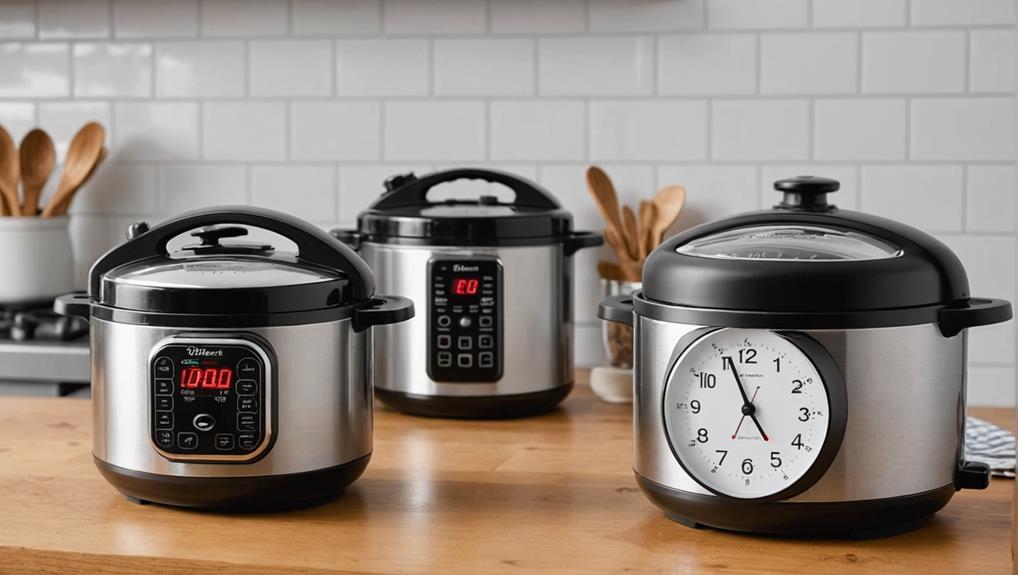
The race against the clock in the kitchen often determines which cooking method you'll choose. When it comes to steam versus pressure cooking, your ingredient choice considerations play a crucial role.
For quick meals, steaming is your go-to option, taking just 10 to 20 minutes for most vegetables and seafood. It's perfect for preserving vibrant colors and textures while retaining maximum nutrients.
However, if you're dealing with tougher ingredients or larger quantities, pressure cooking might be your time-saving hero. This method can transform hour-long recipes into 20 to 30-minute marvels, making it ideal for beans, tough meats, and batch cooking.
Your cooking method preferences should align with your time management strategies. If you're preparing delicate items or smaller portions, steaming offers efficiency and nutrient retention. For denser foods or when cooking in bulk, pressure cooking provides speed and energy efficiency.
User-Friendly Cooking Methods
When it comes to user-friendly cooking methods, both steaming and pressure cooking offer accessible options for home cooks.
These techniques provide innovative ways to prepare easy meals with minimal cleanup, making them ideal for beginners and seasoned chefs alike.
Steamer baskets and electric steamers are straightforward tools for steaming, while multi-cookers with pressure cooking functions offer versatility in meal preparation.
Both methods eliminate the need for added fats or oils, promoting healthier, low-calorie options.
For those seeking to expand their culinary skills, here are four key benefits of these cooking methods:
- Nutrient retention
- Time efficiency
- Flavor enhancement
- Texture preservation
Texture and Consistency Evaluation
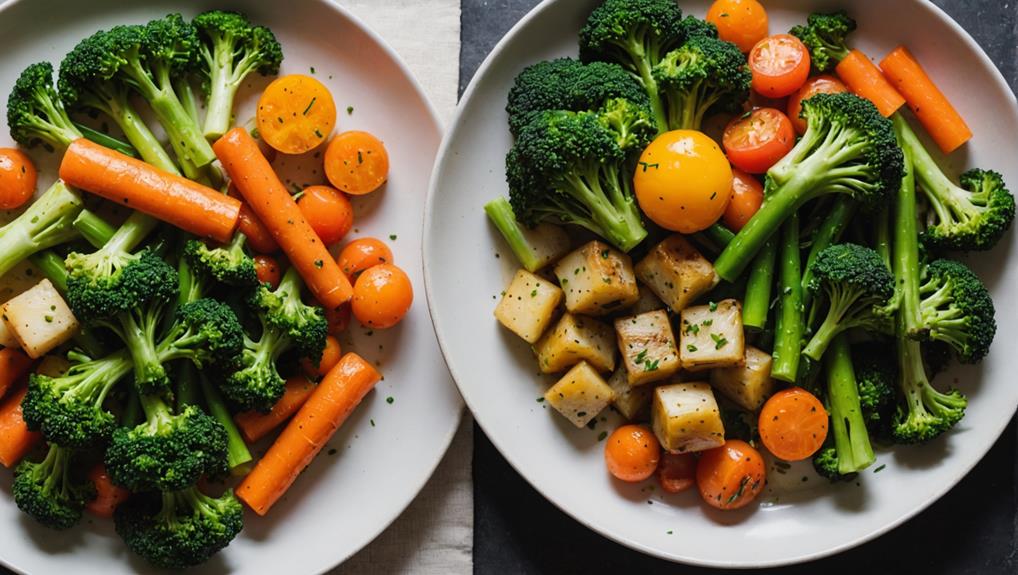
While both steaming and pressure cooking offer unique benefits, their impact on food texture and consistency can vary significantly.
When conducting a texture analysis, you'll find that steaming preserves the natural qualities of many foods. Vegetables like broccoli and carrots retain their crispiness and moisture, resulting in a tender yet firm bite. Seafood lovers, you're in for a treat! Steaming enhances the delicate, flaky texture of fish, allowing its natural flavors to shine.
For poultry enthusiasts, steaming chicken breasts yields juicy, tender results. If you're a fan of dumplings or pastries, steaming is your go-to method, maintaining their delicate structure without the risk of sogginess. Even grains like rice and quinoa benefit from steaming, achieving that coveted light and fluffy texture.
On the flip side, pressure cooking's effects on texture can be more intense. While it's great for tenderizing tough meats, it may lead to denser textures in seafood or overcooked poultry if not carefully monitored.
When considering ingredient suitability, remember that delicate foods often fare better with steaming, while heartier ingredients can withstand pressure cooking's intensity.
Health and Safety Considerations
Beyond texture considerations, health and safety factors play a significant role in choosing between steaming and pressure cooking.
When it comes to nutrient retention, steaming takes the lead, preserving more vitamins and minerals due to lower cooking temperatures and shorter cooking times. However, pressure cooking's rapid process can also minimize nutrient loss if executed correctly.
Safety standards are crucial for both methods. You'll need to master proper equipment maintenance and adhere to manufacturer guidelines, especially for pressure cookers, to prevent accidents from excessive pressure buildup.
Steaming is generally considered safer, reducing the formation of harmful substances like acrylamide.
To maximize health benefits and safety when using these innovative cooking methods:
- Invest in high-quality equipment designed for your chosen method
- Regularly inspect and maintain your cooking tools
- Monitor cooking temperatures closely to prevent nutrient loss
- Follow recommended cooking times to avoid overcooking
Both steaming and pressure cooking offer healthier alternatives to traditional cooking methods by reducing the need for added fats.
Equipment and Cost Analysis
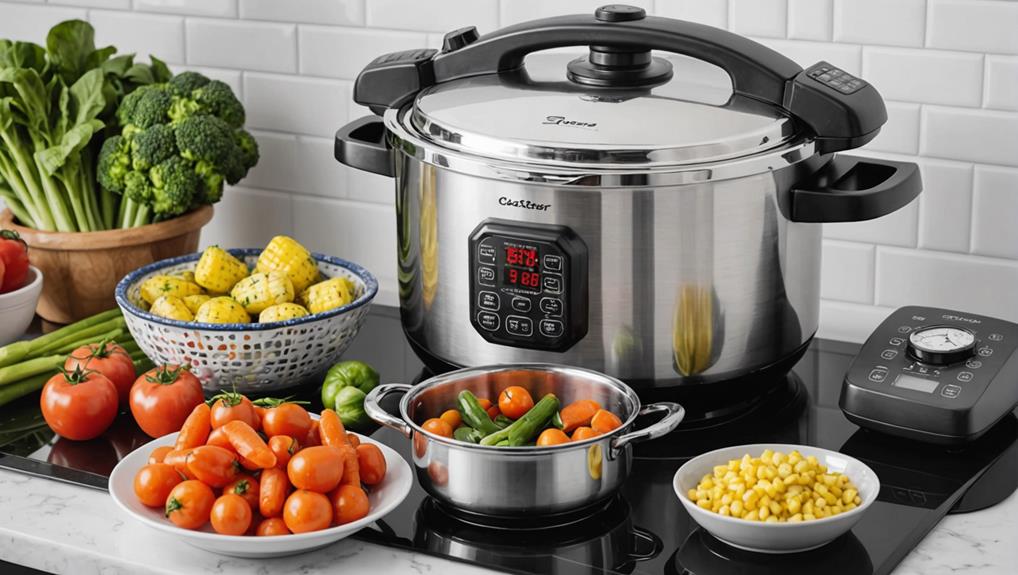
The equipment cost-benefit analysis of steaming versus pressure cooking reveals some interesting insights.
When it comes to steam basket options, you'll find a range of affordable choices, from simple stove-top baskets to electric steamers and microwave bags. These typically cost between $15 and $100, making them accessible for most home cooks.
On the other hand, pressure cooker brands offer a wider price range, starting at $30 for basic models and reaching up to $200 for advanced electric versions with programmable features.
While both methods boast low-cost entry points, the multi cooker advantages become apparent when considering long-term value. By investing in a device that combines steaming and pressure cooking capabilities, you'll save money and kitchen space. These versatile appliances often include additional functions, maximizing your culinary potential.
Maintenance costs for both steaming and pressure cooking equipment are minimal, with few accessories or consumables required. This makes them cost-effective choices for health-conscious, innovative cooks.
Whether you opt for a dedicated steamer, a pressure cooker, or a multi-cooker, you're making a smart investment in your kitchen arsenal that won't break the bank.
Frequently Asked Questions
What Is the Cooking Method of Steam?
You'll love steaming! It's a cutting-edge cooking method using water vapor to cook food. You'll enjoy health benefits, flavor retention, and quick cooking times. It's perfect for preserving nutrients and creating vibrant, delicious meals efficiently.
Which Cooking Technique Cooks the Food by Surrounding It in Steam in a Confined Space?
You'll find pressure steaming surrounds food with steam in a confined space. It's a game-changer for efficiency and flavor retention. You'll experience faster cooking times and enhanced taste, making it an innovative technique for modern, health-conscious cooks.
What Is a Method of Cooking in Steam Trapped and Held in a Covered Container or Foil Wrap?
Unlocking flavor's vault, you're harnessing steam's power in a covered container or foil wrap. This innovative method controls water temperature, preserves food texture, and maximizes nutrient retention. You're creating a culinary microclimate that elevates your dishes effortlessly.
Final Thoughts
You've explored the strengths of both steam and pressure cooking, and while you might think one method reigns supreme, the truth is that each has its place in your kitchen. Your choice depends on your specific needs: nutrition, flavor, efficiency, or versatility. Don't limit yourself to just one method; embrace both techniques to expand your culinary repertoire. By understanding the unique benefits of steam and pressure cooking, you'll become a more versatile and confident cook, able to tackle a wider range of dishes with ease.

